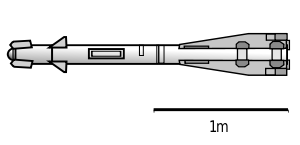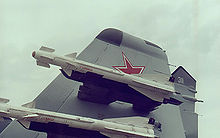- R-60 (missile)
-
Molniya R-60 
Type Short-range Air to Air Missile Place of origin Soviet Union Service history In service 1974- present Production history Manufacturer Vympel Specifications Weight 43.5 kg (96 lb) Length 2090 mm (6 ft 10 in) Diameter 120 mm (4¾ in) Warhead 3 kg (6.6 lb) Detonation
mechanismproximity Engine solid-fuel rocket engine Wingspan 390 mm (15¼ in) Operational
range8 km (5 mi) Flight altitude 20,000 m (65,615 ft) Speed Mach 2.7 Guidance
systeminfrared homing Launch
platformMiG-21, MiG-23, MiG-25, MiG-27, MiG-29, MiG-31, Su-15, Su-17, Su-20, Su-22, Su-24, Su-25, Yak-28, Yak-38, Yak-141, Mi-24, BAE Hawk The Molniya (now Vympel) R-60 (NATO reporting name AA-8 'Aphid') is a lightweight air-to-air missile designed for use by Soviet fighter aircraft. It has been widely exported, and remains in service with the CIS and many other nations.
Contents
History
The R-60 was initially developed for the MiG-23. Work began on the weapon, under the bureau designation K-60 (izdeliye 62), in the late 1960s. Series production began in 1973. It entered service with the designation R-60 (NATO 'Aphid-A').
When introduced, the R-60 was one of the world's smallest air-to-air missiles, with a launch weight of 44 kg (97 lb). It has infrared guidance, with an uncooled Komar (Mosquito) seeker head. Control is by forward rudders with large rear fins. The distinctive canards on the nose, known as "destabilizers," serve to improve the rudders' efficiency at high angles of attack. The R-60 uses a small, 3 kg (6.5 lb) expanding-rod high explosive warhead. Two different types of proximity fuze can be fitted: the standard Strizh (Swift) optical fuse, which can be replaced with a Kolibri active radar fuse. Missiles equipped with the latter fuse were designated R-60K.[1]
According to Russian sources, practical engagement range is about 4,000 m (4,400 yd), although "brochure range" is 8 km (5 mi) at high altitude. The weapon was at until recently one of the most agile air to air missiles, and can be used by aircraft maneuvering at up to 9g against targets maneuvering at up to 8g. A tactical advantage is the short minimum range of only 300 m (328 yd).
Considering that Soviet practice was to manufacture most air-to-air missiles with interchangeable IR-homer and semi-active radar homing seekers, NATO speculated that there might have been a SARH version of the 'Aphid.' However, it is clear that the small size of the 'Aphid' makes a radar-homing version with an antenna of reasonable size impractical, and no such weapon appears to have been contemplated.
An inert training version, alternatively designated UZ-62 and UZR-60, was also built.
An upgraded version, the R-60M (NATO 'Aphid-B'), using a nitrogen-cooled seeker with an expanded view angle of ±20°, was introduced around 1982. Although its seeker is more sensitive than its predecessor, the R-60M has only limited all-aspect capability. Minimum engagement range was further reduced, to only 200 m (218.7 yd).[2] The proximity fuzes had improved resistance to ECM, although both optical and radar fuzes remained available (radar-fuzed R-60Ms with the Kolibri-M fuze are designated R-60KM). The R-60M is 42 mm (1.7 in) longer, and has a heavier, 3.5 kg (7.7 lb) continuous-rod warhead, increasing launch weight to 45 kg (99 lb). In some versions the warhead is apparently laced with about 1.6 kg (3.5 lb) of depleted uranium to increase the penetrating power of the warhead[3]
The inert training version of the R-60M was the R-60MU.
 Two R-60 missiles mounted on a MiG-29K.
Two R-60 missiles mounted on a MiG-29K.
Since 1999, a modified version of the weapon has been used as a surface-to-air missile (SAM) as part of the Yugoslav M55A3B1 towed anti-aircraft artillery system. It has also been seen carried on a twin rail mount on a modified M53/59 Praga armored SPAAG of (former) Czechoslovakian origin. These missiles have been modified with the addition of a first stage booster motor, with the missile's own motor becoming the sustainer. This was done in lieu of modifying the missile's motor for ground launch, as in the case of the US MIM-72 Chaparral.
The current Russian dogfight missile is the Vympel R-73 (AA-11 'Archer'), but large numbers of 'Aphids' remain in service.
Operational history
Russia
On 21 June 1978, a PVO MiG-23M flown by Pilot Captain V. Shkinder shot down two Iranian Boeing CH-47 Chinook helicopters that had trespassed into Soviet airspace, one helicopter being dispatched by two R-60 missiles and the other by cannon fire.
Syria
Several Russian reports affirm the AA-8 was widely used during the 1982 Lebanon war, and it was the main weapon used by the Syrians in air to air combat. Some Russian reports affirm that the R-60 was the most successful air to air missile deployed by the Syrians in Lebanon over the Bekaa Valley in 1982[4][5] According to Israeli reports, the vast majority of air to air combats did consisted of visual range dogfights, and this has been also confirmed by Russian sources. The Russian reports also mentioned that several F-4s, F-16, IAI Kfirs were destroyed by R-60s among other aircrafts. Although some Israeli F-4s and Kfirs were lost in 1982, they however claim that SAMs were the only weapons that shot down all those aircrafts they lost.
Cuba
On 27 September 1987, during Operation Moduler, an attempt was mounted to intercept two Cuban FAR MiG-23MLs. Captain Arthur Piercy's F1CZ was damaged by either an AA-7 Apex or an R-60 fired head-on by Major Alberto Ley Rivas. The explosion destroyed the aircraft's drag chute and damaged the hydraulics. Piercy was able to recover to AFB Rundu, but the aircraft overshot the runway. The impact with the rough terrain caused Piercy's ejection seat to fire, but he failed to separate from the seat and suffered major spinal injuries.[6][7]
Iraq
In the Gulf War of 1990-1991, Iraqi Pilot Jameel Sayhood while flying a MIG-29, is claimed to have shot down a British RAF Tornado GR.1A (ZA467) piloted by Gary Lennox and Adrian Weeks, with a R-60MK missile on January 19, 1991.[8] However, this aircraft is recorded as having been lost to ground fire three days later on a mission to Ar Rutbah.[9][10][11]
An Iraqi air to air victory occurred when a MiG-25 armed with either R-60, or R-40 missiles shot down a Predator on December 23, 2002.
India
An Indian Air Force MiG-21s used infra-red homing R-60 to bring down the Pakistani Naval Breguet Atlantique in 1999 which intruded over Indian Airspace, part of the wreckage was found in contested territory, this incident is widely known as the Atlantique Incident.
Operators
Current
 Abkhazia[12]
Abkhazia[12]- Supported by Russia during Russo-Georgian War.
 Armenia
Armenia Croatia
Croatia Cuba
Cuba Bulgaria
Bulgaria Georgia[13]
Georgia[13] India
India Iran
Iran Malaysia
Malaysia North Korea
North Korea Peru
Peru Poland[14]
Poland[14] Slovakia
Slovakia Serbia
Serbia Syria
Syria Russia
Russia Vietnam
Vietnam
Former
 Iraq
Iraq- As of Saddam's Era.
 Soviet Union
Soviet Union- Passed on successor states.
 Yugoslavia
Yugoslavia- Passed on successor states.
Notes
- ^ Gordon, Yefim, Soviet/Russian Aircraft Weapons Since World War Two (Hinckley, England: Midland Publishing, 2004), pp. 29-32.
- ^ Mladenov, Alexander, "Air-to-air missiles for the fighter 'Flogger,' International Air Power Review vol. 14, 2004, pp. 90-91.
- ^ "Health Risks of Using Depleted Uranium," Venik's Aviation, 2001.
- ^ SyAAF MiG-23 comabat record.
- ^ MiG-23 in the Middle-East.
- ^ Lord, Dick (2000). Vlamgat: The Story of the Mirage F1 in the South African Air Force. Covos-Day. ISBN 0620241160.
- ^ "Piloto SAAF derribado por MiG-23 cubano". Archived from the original on 2009-10-22. http://web.archive.org/web/20091022171409/http://geocities.com/urrib2000/ArticPiercy.html. Retrieved 2008-12-20.
- ^ "Iraqi air-air victories during the Gulf War 1991". safarikovi.org.com. 2004. http://aces.safarikovi.org/victories/victories-iraq-gulf.war.pdf. Retrieved 2009-12-07.
- ^ "Coastal Command History - Squadrons". http://www.raf.mod.uk/gulf/bases2.html#saudi.
- ^ "ASN Aircraft accident 22-JAN-1991 Panavia Tornado GR1 ZA467." Flight Safety Foundation via www.aviation-safety.net. Retrieved: 21 December 2009.
- ^ "RAF Crash Data". tornado-data.com. 2004. http://www.tornado-data.com/Production/RAF%20Crash%20Data.pdf. Retrieved 2010-09-11.
- ^ http://s54.radikal.ru/i143/0904/02/b55c9a23f6c8.jpg
- ^ http://geo-army.ge/index.php?option=com_content&view=article&id=39&Itemid=9&lang=en
- ^ http://altair.com.pl/files/news/2010/09/i-i10-09-010orlik.jpg
References
- Gordon, Yefim (2004). Soviet/Russian Aircraft Weapons Since World War Two. Hinckley, England: Midland Publishing. ISBN 1-85780-188-1.
Categories:- Soviet Air Force guided missiles
- Air-to-air missiles of Russia
- Air-to-air missiles of the Soviet Union
- Cold War air-to-air missiles of the Soviet Union
Wikimedia Foundation. 2010.
